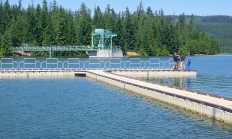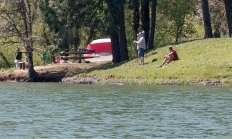
Search myodfw.com
A quiet, modest, unobtrusive little bird that must be sought to be seen in its shady retreats, this little-studied species can easily be overlooked. It is typically associated with oaks and mixed woodlands, where it hops along the foliage hunting for insects. In winter it forages with flocks of chickadees, kinglets, and nuthatches. This is Oregon's only resident vireo. Although it is sometimes referred to as non-migratory, some seasonal movement has been observed. Similar in appearance and behavior to the more common and widespread Ruby-crowned kinglet. Hear the song of the Hutton's vireo Photo by Greg Gilson

Gnat Creek Hatchery was constructed in 1960 as part of the Columbia River Fisheries Development Program (Mitchell Act)—a program to enhance declining fish runs in the Columbia River Basin. The facility is used for egg incubation and rearing of spring Chinook and winter steelhead. Most of the production is released off-station. The hatchery is an easy drive toward Oregon’s coast on Highway 30 and a visitor-friendly place for the entire family. With lots to do, located on beautiful Gnat Creek and tucked away amid the rainforest, this is a worthwhile stop on the way to the coast.
This majestically crested bird is often heard before being seen due to its conspicuous harsh rattling call. Kingfishers are most frequently associated with lake and pond shorelines and islands, as well as coastal dunes with ponds and widely scattered shrubs and trees. They hunt from a vantage point above water such as an overhead branch, telephone wires along shore lines or pilings of piers. This is a common permanent resident throughout most of the state except in the north Lake and east Deschutes counties where open water is generally absent Hear the call of the belted kingfisher Photo from ODFW

Sauvie Island Wildlife Area was established in 1947 with primary objectives of protecting and improving waterfowl habitat and providing a public hunting area. The initial purchase of five acres in 1940 and subsequent purchases through 2012 has brought the wildlife area to its present size of 11,643 acres, of which 8,153 acres are under fee title to the department and 3,490 acres are managed through a cooperative agreement with the Oregon Department of State Lands. Currently, the wildlife area supports a biologically diverse association of wildlife which includes at least 275 species of birds, 37 species of mammals, 12 species


Chukars are ground-loving birds that quickly run uphill or burst from cover with rapid wing-beats and a characteristic whitoo call if alarmed. Introduced by managers wishing to increase hunting opportunities in arid western North America, the chukar is a very successful exotic species that occupies habitats where few other gamebirds exist. It is the most harvested upland bird in Oregon. It is a common permanent resident of eastern Oregon. Populations are distributed in steppe habitats along the breaks of the Columbia, John Day, Snake, Owyhee, Deschutes, Malheur, Burnt and Grand Ronde rivers and lesser watercourses or reservoirs. Hear the call

Establishment of the Bridge Creek Wildlife Area initially started in 1961 when a parcel of land was purchased from the Frank Hilbert estate. After the initial purchase, several private holdings were acquired to consolidate the land under department ownership. The last parcel was purchased from the Colvin Cattle Company in 1975. The primary purpose of the wildlife area is to maintain and protect a key historic winter range for Rocky Mountain elk ( Cervus elaphus nelsoni).





Glen Otto Park - 1102 E Historic Columbia River Hwy. Troutdale, 97060
Hunting involves a deadly weapon that can kill more than just your target. Hunting and handling your gun safely MUST be a top priority. Start with the fundamentals Start by learning these four gun safety fundamentals and you’ll be well on you way to a lifetime of safe hunting. Assume all guns are always loaded. The primary benefit of handling all guns as if they were loaded, is that it will help you develop safe gun handling habits. Never let the muzzle of the gun (the shooting end) point at something you’re not willing to shoot. Often referred to as

Build bird houses for ODFW. Teach families to fish. Walk a stream or hike in a forest looking for animals or sign of animals to support various studies. Teach others to hunt or about hunter safety. Assist Marine Reserves with onshore or offshore studies. These are just some of the things ODFW volunteers do to help protect and enhance Oregon's natural resources. Current volunteer opportunities



With short pointed wings and long narrow tails, these small falcons are well built for fast pursuit and mid-air attacks. Sexes differ in color and size, with adult males about 25 percent smaller by weight than females. Males range from blackish gray to pale blue-gray on the back with a reddish wash along sides of the breast and a banded tail; females have brownish backs. In winter, it can be found throughout the state in open or semi-open habitats, but it is most regular near major estuaries, lakes, reservoirs, and occasionally in cities where food supplies are reliable. For nesting

Updated November 5, 2025 Subscribe for updates Starting Jan. 1, 2026, an Ocean Endorsement is needed for most recreational anglers fishing in the ocean. Check the Ocean Endorsement page for more information. Ocean Endorsement
